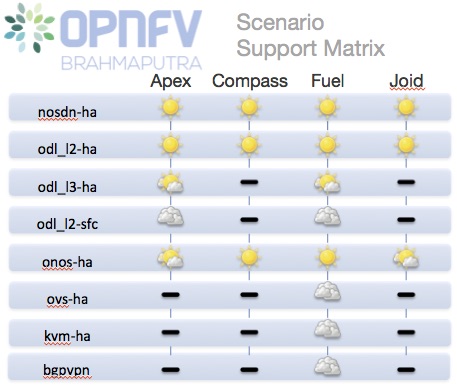Configuration Options¶
OPNFV provides a variety of virtual infrastructure deployments called scenarios designed to host virtualised network functions (VNF’s). Each scenario provide specific capabilities and/or components aimed to solve specific problems for the deployment of VNF’s. A scenario may include components such as OpenStack, OpenDaylight, OVS, KVM etc. where each scenario will include different source components or configurations.
OPNFV Scenarios¶
Each OPNFV scenario provides unique features and capabilities, it is important to understand your target platform capabilities before installing and configuring your target scenario. This configuration guide outlines how to install and configure components in order to enable the features you require.
Scenarios are implemented as deployable compositions through integration with an installation tool. OPNFV supports multiple installation tools and for any given release not all tools will support all scenarios. While our target is to establish parity across the installation tools to ensure they can provide all scenarios, the practical challenge of achieving that goal for any given feature and release results in some disparity.
Brahmaputra scenario overeview¶
The following table provides an overview of the installation tools and available scenario’s in the Brahmaputra release of OPNFV.

Scenario status is indicated by a weather pattern icon. All scenarios listed with a weather pattern are possible to deploy and run in your environment or a Pharos lab, however they may have known limitations or issues as indicated by the icon.
Weather pattern icon legend:
| Weather Icon | Scenario Status |
|---|---|

|
Stable, no known issues |

|
Stable, documented limitations |

|
Deployable, stability or feature limitations |

|
Not deployed with this installer |
Scenarios that are not yet in a state of “Stable, no known issues” will continue to be stabilised and updates will be made on the stable/brahmaputra branch. While we intend that all Brahmaputra scenarios should be stable it is worth checking regularly to see the current status. Due to our dependency on upstream communities and code some issues may not be resolved prior to the C release.
Scenario Naming¶
In OPNFV scenarios are identified by short scenario names, these names follow a scheme that identifies the key components and behaviours of the scenario. The rules for scenario naming are as follows:
os-[controller]-[feature]-[mode]-[option]
- Details of the fields are
- os: mandatory
- Refers to the platform type used
- possible value: os (OpenStack)
- os: mandatory
[controller]: mandatory
- Refers to the SDN controller integrated in the platform
- example values: nosdn, ocl, odl, onos
- [feature]: mandatory
- Refers to the feature projects supported by the scenario
- example values: nofeature, kvm, ovs, sfc
- [mode]: mandatory
- Refers to the deployment type, which may include for instance high availability
- possible values: ha, noha
- [option]: optional
- Used for the scenarios those do not fit into naming scheme.
- The optional field in the short scenario name should not be included if there is no optional scenario.
Some examples of supported scenario names are:
- os-nosdn-kvm-noha
- This is an OpenStack based deployment using neutron including the OPNFV enhanced KVM hypervisor
- os-onos-nofeature-ha
- This is an OpenStack deployment in high availability mode including ONOS as the SDN controller
- os-odl_l2-sfc
- This is an OpenStack deployment using OpenDaylight and OVS enabled with SFC features
Installing your scenario¶
There are two main methods of deploying your target scenario, one method is to follow this guide which will walk you through the process of deploying to your hardware using scripts or ISO images, the other method is to set up a Jenkins slave and connect your infrastructure to the OPNFV Jenkins master.
For the purposes of evaluation and development a number of Brahmaputra scenarios are able to be deployed virtually to mitigate the requirements on physical infrastructure. Details and instructions on performing virtual deployments can be found in the installer specific installation instructions.
To set up a Jenkins slave for automated deployment to your lab, refer to the Jenkins slave connect guide.
This document will describe how to install and configure your target OPNFV scenarios. Remember to check the associated validation procedures section following your installation for details of the use cases and tests that have been run.
